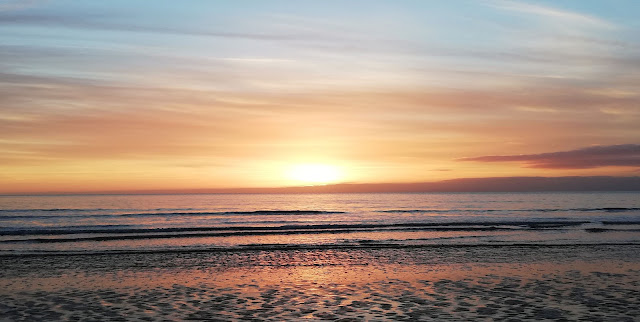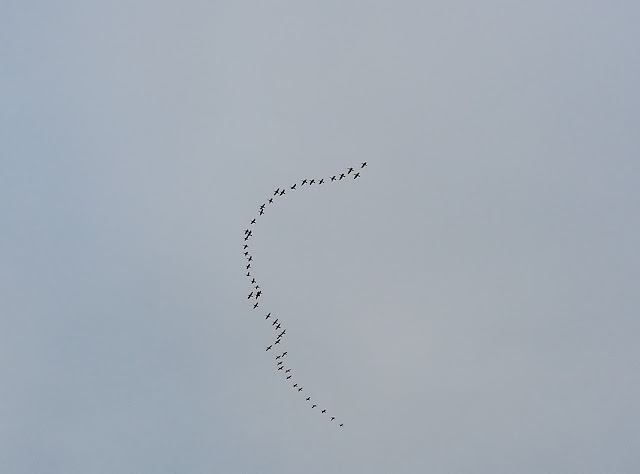We take the little Northern Line train south from Carlisle, Cumbria. Just a few carriages, not many passengers, the outside is grimy, giving the impression of being hard working, industrious, no nonsense, no shiny veneer, no immaculate facade. A tall step up from the platform, and windows that can be opened manually. This is just the kind of train I like, although it cannot quite match Balkan trains.
It’s a cold, bright and sunny day. Reaching St Bees in late afternoon feels like arriving on a Greek island. A walk along the beach, with glorious colours of sundown. The part of the beach nearest the promenade is made of pebbles, and beyond that, long stretches of sand, some flat sand, some ribbed sand, hard little sand hills with valleys of water.
The stones on St Bees beach are mostly round, some of them almost perfect circles. And all smooth, as if carved by a sculptor’s hand. And the sculptor is the sea, its constant movement rubbing away all corners and edges, flattening all bumps, eroding all crevices until they are left here, idyllic ocean offerings. The colours are bluish-grey, slate-blue, sea-green, pinkish red & brownish-purple and there is nothing I can imagine more harmoniously coloured than these round stones, worn into perfect smoothness and swept up by the sea.
The next morning the sky is cloudy, overcast, with a slight mist in the air. We walk from the beach up the cliff, to the coast path.
There’s a view south of Scafell Pike, the highest mountain in England, so the information board says.
St Bees in the valley & Scafell Pike in the distance
looking south to Seascale & Ravenglass
The view north shows the Scottish mountains, and to the west the Isle of Man is just discernible.
At one point it’s possible to descend from the cliff to Fleswick bay. It’s surrounded by the red sandstone cliffs and has a slightly menacing atmosphere. On one side, a huge slab of cliff has fallen off onto rocks. The cliff side is a mosaic of segments and splinters, a kind of red parquet of stone. 
Some flat slab walls are inscribed with careful lettering by earlier visitors, intent on making their mark. At times I felt a tremor under my feet. Wondered if there were underwater caves, dug out by the insistent pounding of the waves, though there is no sign of them. Or perhaps because the cliffs on either side of the small bay funnelled the sea sound and the sea thump and pound against the pebbles and the rocks? I was glad to leave the little bay, climb back up the stony stream bed, back up to the cliff top and the views out to the grey and shifting tidal mass of water.
And in places where parts of the cliff side is visible, there are ledges favoured by a group of razorbills or guillemots (lower ledge), nestled into the side like miniature penguins. On the ledge above, a few all-black birds which I think are cormorants. The group of guillemots are motionless, tucked into shelter, only spotted with binoculars.
But a little further on, two birds, possibly a cormorant and a guillemot, are on a cliff ledge very close to the path. I approach cautiously to take the photo so as not to disturb the cormorant which looks about to fly away (but it doesn’t).
The path goes past a lighthouse, and further on, Birkham’s quarry, only used, an information board says, in February and March, so as not to disturb the birds in breeding season. The dark red sandstone dug out of the ground here has been used in many places (including Carlisle Cathedral) both local and international.
The stone looks as if it has been soaked in earth and water and the combination produces this dark red colour.
A flock of geese passes overhead
This lovely rock formation looks like a face in profile, eye shut against the fierce wind, which also blows back its bristly almost Mohawk coiffure.

The last part of the walk descends to sea level, then there’s the approach to Whitehaven’s Candlestick harbour and marina.
It reminds me of Kyrenia harbour in Cyprus, with its sunlit bay packed full of boats, and so many cafes all along the waterfront. It reminds me but it is totally unlike it, the only points of resemblance being a horseshoe shaped harbour, with water and boats.
Kyrenia Harbour, Cyprus
But the mind does like to look for similarities, without any prompting it comes up with associations. There is no sunshine here, no awning-covered cafes, few buildings, and while Kyrenia harbour is wrapped with buildings which feel protective rather than crowding, Whitehaven feels exposed and bare. A walk round the harbour, through the vast supermarket car park, and there’s the station, where we board a train to take us back to St Bees.













Comments